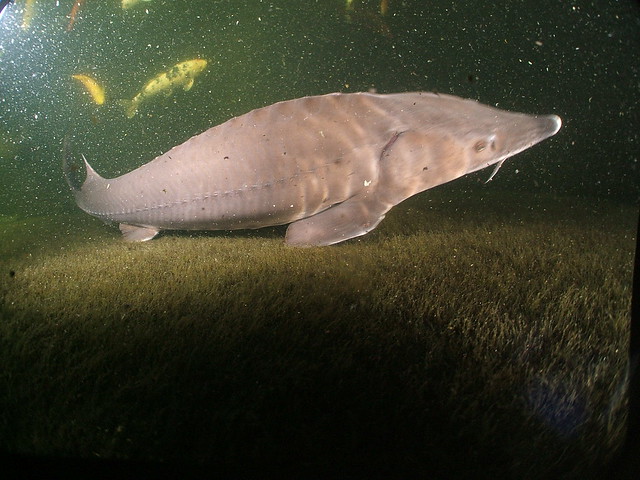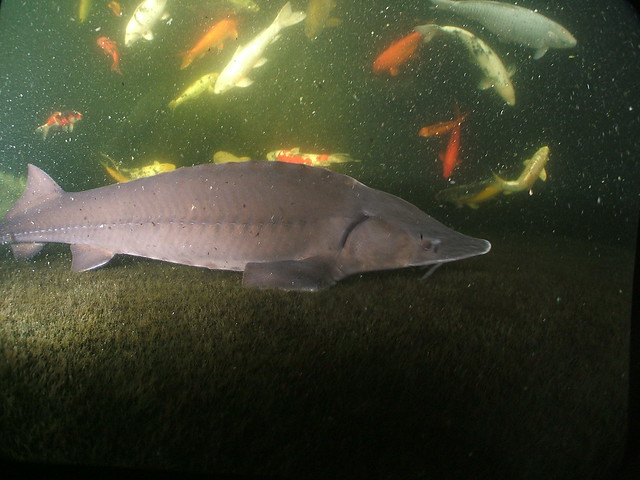Since I've already mentioned primeval looking things this week, lets keep going with some sturgeon. Just to make sure everyone is onboard with what a sturgeon is, this is a sturgeon in my parent's koi pond. My gut feeling is that more specifically it is Acipenser baerii, the Siberian sturgeon.
This particular species will grow to roughly 2 metres (6 feet). Let's address first of all why we can have species like this in our ponds. Sturgeon culture is something that has long been desirable. Why? Caviar. The best caviar is the roe of various sturgeon species. Obviously removing adult females of a species from populations together with all their eggs is not a remotely sustainable form of harvest. This is particularly so since like the salmonoids, most sturgeon migrate from brackish coastal waters into rivers to spawn - big fish going through bottlenecks are easy to catch and sturgeon populations have basically been freefalling due to demand for their eggs. Happily they are now being cultured very successfully and farmed caviar is now available (as, as a result, are fish for ponds). Those of you following my twitter feed may already have seen this guardian video showing a sturgeon farm but if you haven't it is well worth a look. A really cool enterprise which should be encouraged.
So now we have farmed sturgeon what does that mean? It is of interest to me for 3 reasons:
1. Destruction of the wild-caught caviar industry
This would unquestionably be a good thing from an environmental point of view, the farms can be run sustainably, humanely and profitably - all of which are good for those involved.
2. Keeping sturgeon in garden ponds
As the photos above suggest, it is possible to keep these spectacular fish in garden ponds. Lets be clear though that they aren't goldfish and things like this need to be properly thought through. As befits a streamlined species from rivers and so forth, it needs good oxygen levels. Cool, pure water is also unsurprisingly a requisite as is space so you need a big, well filtered, deep pond.
In addition, it might not be a surprise to learn that bigger sturgeon can and will eat small fish. What they won't do is eat blanketweed and pure crap off the bottom of the pond. These are big bottom feeding fish so you need to get food to the bottom of the pond for them eg sinking pellets.
Finally (and slightly ridiculously) small sturgeon can get entangled in pond weed. They don't have a reverse and if they aren't big enough to plough through whatever has tangled them they can die. Not cool. So if you can meet all the above go for it. If not please think twice. More here.
3. Wild sturgeon introductions
Britain and the rest of western europe used to have runs of European Sturgeon (Acipenser sturio) a large species growing to 4metres+ (13 feet!) however it has also been suggested parts of the UK had their own endemic species. Sturgeon were certainly never common here during the time people kept records of such things. They certainly did breed in Western Europe however and it seems possible the British fish were not vagrants but the remnants of a very small breeding population. Vagrant or breeders they were rare enough to be deemed "Royal Fish" alongside whales and dolphins (which as we all know are not fish but still). So should we be releasing farmed sturgeon into British or European waters to reintroduce the species? Well we certainly shouldn't be introducing those species currently being farmed across Europe They're not our native species and could hybridise with the remaining European specimens. I see no reason we shouldn't [re]introduce European stock if farmed fish can be produced however. We've reintroduced mammals, amphibians and birds. Why not a fish?
Well we would need to obtain broodstock, produce fry and identify suitable rivers but a 10 foot+ freshwater fish is about as impressive as British megafauna can get and even a small population would be likely to have significant economic benefits for the rivers chosen (primarily from anglers but also perhaps tourists visiting farms). If all this sounds farfetched consider that in 2007 3,000 European Sturgeon were reintroduced into the Gironde (and this programme is ongoing), in an attempt to supplement the last significant breeding population. So the knowhow exists. I think a lot more research is needed before a UK introduction is seriously contemplated. Genetic testing of preserved specimens and so forth would be a good start; there is too much "sturgeon lore" in the British records to trust purely written records. The Gironde population will if it grows doubtless contribute vagrants to many areas of Europe including the UK so maybe it'll happen by itself anyway.......
BTW personally I think caviar tastes like crap - I had it once aged 18 and haven't touched the stuff since.
Well we would need to obtain broodstock, produce fry and identify suitable rivers but a 10 foot+ freshwater fish is about as impressive as British megafauna can get and even a small population would be likely to have significant economic benefits for the rivers chosen (primarily from anglers but also perhaps tourists visiting farms). If all this sounds farfetched consider that in 2007 3,000 European Sturgeon were reintroduced into the Gironde (and this programme is ongoing), in an attempt to supplement the last significant breeding population. So the knowhow exists. I think a lot more research is needed before a UK introduction is seriously contemplated. Genetic testing of preserved specimens and so forth would be a good start; there is too much "sturgeon lore" in the British records to trust purely written records. The Gironde population will if it grows doubtless contribute vagrants to many areas of Europe including the UK so maybe it'll happen by itself anyway.......
BTW personally I think caviar tastes like crap - I had it once aged 18 and haven't touched the stuff since.


No comments:
Post a Comment